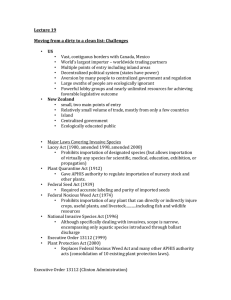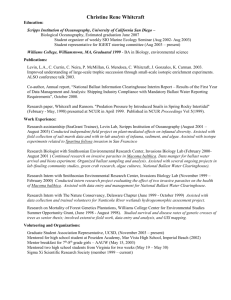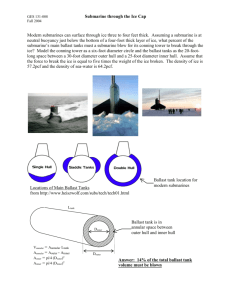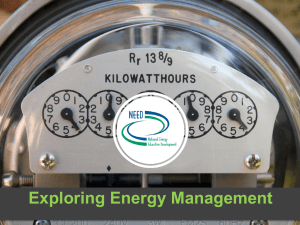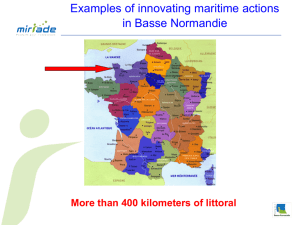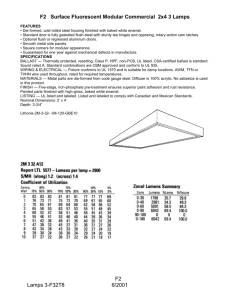RECENT DEVELOPMENT THE CURRENT STATE OF BALLAST WATER REGULATIONS
advertisement
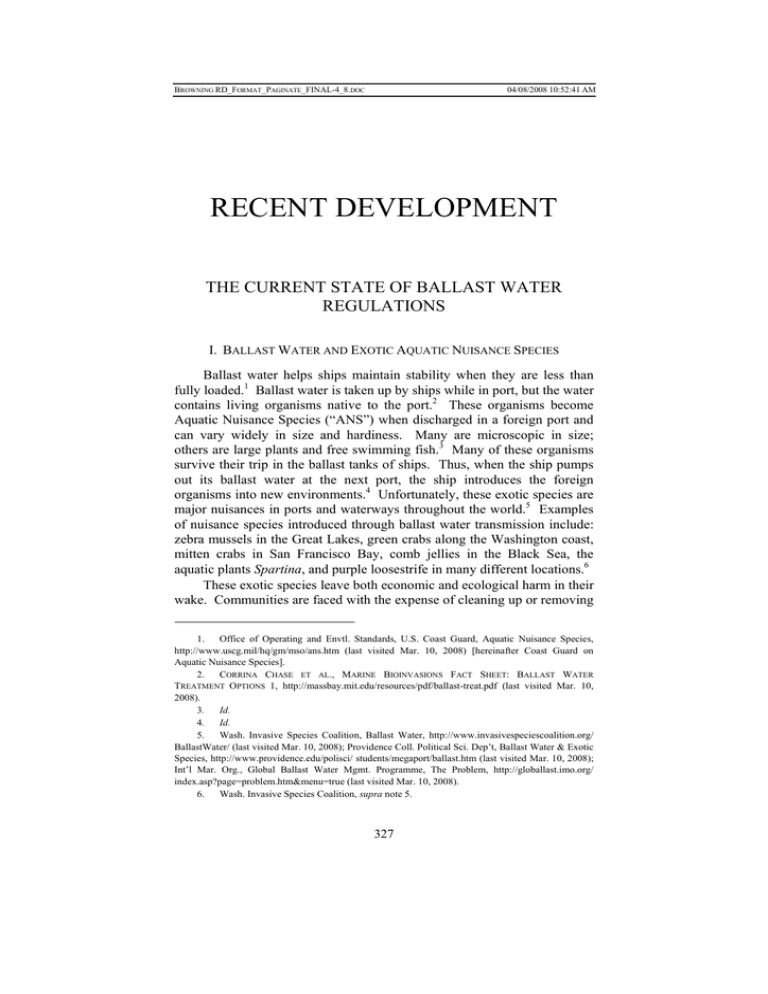
BROWNING RD_FORMAT_PAGINATE_FINAL-4_8.DOC 04/08/2008 10:52:41 AM RECENT DEVELOPMENT THE CURRENT STATE OF BALLAST WATER REGULATIONS I. BALLAST WATER AND EXOTIC AQUATIC NUISANCE SPECIES Ballast water helps ships maintain stability when they are less than fully loaded.1 Ballast water is taken up by ships while in port, but the water contains living organisms native to the port.2 These organisms become Aquatic Nuisance Species (“ANS”) when discharged in a foreign port and can vary widely in size and hardiness. Many are microscopic in size; others are large plants and free swimming fish.3 Many of these organisms survive their trip in the ballast tanks of ships. Thus, when the ship pumps out its ballast water at the next port, the ship introduces the foreign organisms into new environments.4 Unfortunately, these exotic species are major nuisances in ports and waterways throughout the world.5 Examples of nuisance species introduced through ballast water transmission include: zebra mussels in the Great Lakes, green crabs along the Washington coast, mitten crabs in San Francisco Bay, comb jellies in the Black Sea, the aquatic plants Spartina, and purple loosestrife in many different locations.6 These exotic species leave both economic and ecological harm in their wake. Communities are faced with the expense of cleaning up or removing 1. Office of Operating and Envtl. Standards, U.S. Coast Guard, Aquatic Nuisance Species, http://www.uscg.mil/hq/gm/mso/ans.htm (last visited Mar. 10, 2008) [hereinafter Coast Guard on Aquatic Nuisance Species]. 2. CORRINA CHASE ET AL., MARINE BIOINVASIONS FACT SHEET: BALLAST WATER TREATMENT OPTIONS 1, http://massbay.mit.edu/resources/pdf/ballast-treat.pdf (last visited Mar. 10, 2008). 3. Id. 4. Id. 5. Wash. Invasive Species Coalition, Ballast Water, http://www.invasivespeciescoalition.org/ BallastWater/ (last visited Mar. 10, 2008); Providence Coll. Political Sci. Dep’t, Ballast Water & Exotic Species, http://www.providence.edu/polisci/ students/megaport/ballast.htm (last visited Mar. 10, 2008); Int’l Mar. Org., Global Ballast Water Mgmt. Programme, The Problem, http://globallast.imo.org/ index.asp?page=problem.htm&menu=true (last visited Mar. 10, 2008). 6. Wash. Invasive Species Coalition, supra note 5. 327 BROWNING RD_FORMAT_PAGINATE_FINAL-4_8.DOC 328 04/08/2008 10:52:41 AM ENVIRONMENTAL & ENERGY LAW & POLICY J. [2:2 the invaders, when possible.7 Invasive species may out-compete native species, including some commercially valuable species.8 Additionally, the invasive species may eat the eggs and larvae of commercially valuable species, such as salmon and Dungeness Crab.9 Often, the newly introduced species have no native predators and may be more aggressive, or simply have faster reproductive cycles than native species.10 Once introduced into nonnative waters, it is usually prohibitively expensive, if not impossible, to remove the invasive organisms.11 Several remedies are available to slow down this form of biological invasion of coastal and port waters.12 Ballast water can be chemically treated or filtered before discharge.13 Alternatively, ships can exchange the ballast water picked up in prior ports with water from the open ocean.14 This alternative leaves the potentially harmful species out in the open ocean where they are less likely to survive.15 Because ocean water usually contains fewer organisms than port water and because the organisms it does contain are less likely to thrive in coastal port environments, this option may abate some of the economic and ecological harm.16 It is very difficult to determine precisely how many exotic species have invaded the world’s ports.17 Recent international interest in the problem has led to increased regulation designed to limit the further spread of invasive species. This Recent Development will discuss the current regulatory regime in the United States and Canada aimed at controlling the spread of invasive species through ballast water and will briefly explore current U.S. efforts to control the spread of exotic species into U.S. ports. 7. Id. 8. Id. 9. Wash. Invasive Species Coalition, Examples of Invaders, http://www.invasivespeciescoalition.org/BallastWater/Examples%20of%20Invaders/document_view (last visited Mar. 10, 2008). 10. Id. 11. Wash. Invasive Species Coalition, Invasive Tunicate, http://www.invasivespeciescoalition.org/BallastWater/tunicate/document_view (last visited Mar. 10, 2008). 12. CHASE ET AL., supra note 2, at 1. 13. Id. at 2–3. 14. Id. at 1–2. 15. Id. at 1. 16. Id. 17. See ANDREW N. COHEN & JAMES T. CARLTON, NONINDIGENOUS AQUATIC SPECIES IN A UNITED STATES ESTUARY: A CASE STUDY OF THE BIOLOGICAL INVASIONS OF THE SAN FRANCISCO BAY AND DELTA 8–19 (1995), available at http://www.anstaskforce.gov/Documents/sfinvade.htm (stating that information about the effects of invasive species is scattered across a multitude of sources). See generally MARINE BIOINVASIONS, CAL. SEA GRANT & MASS. INST. OF TECH. SEA GRANT (2003), available at http://massbay.mit.edu/publications/marinebioinvasions/mbi3_abstract_book.pdf (illustrating the wide variety of current ongoing research on exotic species in the marine environment). BROWNING RD_FORMAT_PAGINATE_FINAL-4_8.DOC 2008] 04/08/2008 10:52:41 AM BALLAST WATER REGULATIONS 329 II. INTERNATIONAL REGULATIONS OF BALLAST WATER: THE IMO CONVENTION The International Maritime Organization (“IMO”) is the United Nations agency responsible for the international regulation of ship safety and the prevention of marine pollution. Therefore it has the expertise and responsibility to deal with the problems caused by the release of ballast water-containing invasive species.18 In February 2004, the IMO held a special diplomatic conference in London to address this issue.19 The conference resulted in an agreement titled the International Convention for the Control and Management of Ships’ Ballast Water & Sediments (the “Convention”). The Convention lays out regulations to control the spread of exotic species through ship ballast water.20 The guidelines adopted by the Convention require shipowners to develop a Ballast Water Management Program, through which the discharge of ballast water is regulated and recorded by ships.21 These programs are designed to minimize the transfer of biological organisms through ballast water discharge. The IMO guidelines provide that ballast water released into port waters shall have a limited number of biological organisms.22 The IMO has provided guidance for the development of these programs to accomplish the stated goals.23 Some of the suggested practices include: (1) ballast water should only be taken up outside the port and far from coastal waters; (2) ballast water should not be taken up when there is a high likelihood of taking in potentially harmful organisms such as: (a) in shallow water; (b) when there is an algal bloom; (c) at night when organisms rise up the water column; (d) near sewage outfalls or aquaculture operations and where tidal flushing is poor;24 and (3) the discharge of 18. Int’l Mar. Org., Global Ballast Water Mgmt. Programme, The International Response, http://globallast.imo.org/index.asp?page=internat_response.htm&menu=true (last visited Mar. 10, 2008) [hereinafter International Response]. 19. Int’l Mar. Org., Global Ballast Water Mgmt. Programme, Ballast Water Convention Adopted, http://globallast.imo.org/index.asp?page=mepc.htm&menu=true (last visited Mar. 10, 2008) [hereinafter New Convention]. 20. See Int’l Mar. Org. [IMO], Global Guidelines for the Control and Management of Ships’ Ballast Water to Minimize the Transfer of Harmful Aquatic Organisms and Pathogens, IMO Assemb. Res. A.868(20), ch. 7–11 (Nov. 27, 1997) [hereinafter IMO Guidelines], available at http://globallast.imo.org/868%20english.pdf. 21. Id. 22. The Convention’s Ballast Water Performance Standard, set forth in Regulation D-2, requires that: Ships conducting ballast water management shall discharge less than 10 viable organisms per cubic meter greater than or equal to 50 micrometers in minimum dimension and less than 10 viable organisms per milliliter less than 50 micrometers in minimum dimension and greater than or equal to 10 micrometers in minimum dimension; and discharge of the indicator microbes shall not exceed the specified concentrations. New Convention, supra note 19. 23. International Response, supra note 18. 24. The Marine Env’t Prot. Comm., IMO, Guidelines for Ballast Water Management Equivalent BROWNING RD_FORMAT_PAGINATE_FINAL-4_8.DOC 330 04/08/2008 10:52:41 AM ENVIRONMENTAL & ENERGY LAW & POLICY J. [2:2 ballast water should occur in deep ocean water with at least a 95% volumetric efficiency.25 These guidelines provide exceptions for the safety of the ship and crew but require reporting of occasions when ballast water exchange does not occur as required by each ship’s Ballast Water Management Plan.26 Ships may also use active substances to remove harmful organisms from ballast water if the substances are an approved part of their Ballast Water Management Program.27 Active substances include organisms and chemicals that are designed to kill or neutralize harmful organisms.28 Such processes, however, carry with them toxicity threats that must be considered.29 Treated ballast water should be tested before release, so as not to release toxic substances into port waters that might harm native organisms.30 Although the Convention has been adopted by IMO member states, many of the signatories have developed their own legislation addressing the ballast water problem.31 The legislation often follows the IMO guidelines, although it may be more stringent in order to protect a country’s coastal waters and ocean resources.32 A. Canada: New Regulations Implemented in 2006 On June 28, 2006, Canada announced the publication of the Ballast Water Control and Management Regulations.33 These regulations are part of the Canada Shipping Act.34 Prior to the implementation of the new regulations, Canada had a voluntary set of guidelines for regulating ballast Compliance (G3), Res..123(53) (July 22, 2005), available at http://www.uscg.mil/hq/gm/mso/docs/ G3_BW_Equivalent_Compliance.pdf. 25. New Convention, supra note 19 (stating that ballast exchange should occur in water 200 meters deep, 200 nautical miles from shore when possible, but at least 50 nautical miles from shore in all cases); see also THE MARINE ENV’T PROT. COMM., GUIDELINES FOR BALLAST WATER EXCHANGE (G6), ANNEX 2, MPEC 124.53 (2005), available at http://www.uscg.mil/hq/gm/mso/docs/G6_BWE.pdf. 26. The Marine Env’t Prot. Comm., IMO, Guidelines for Ballast Water Exchange (G6), Res. 124.53 (July 22, 2005), available at http://www.uscg.mil/hq/gm/mso/docs/G6_BWE.pdf (stating that a ship should have an individualized Ballast Water Management Plan that is developed based on the capabilities and needs of the ship, and that if a ballast exchange does not occur then the reasons for that failure will be recorded in the Ballast Water Handbook). 27. The Marine Env’t Prot. Comm., IMO, Procedure for Approval of Ballast Water Management Systems that make use of Active Substances (G9), Res. 126(53) (July 22, 2005), available at http://www.uscg.mil/hq/g-m/mso/docs/G9_BWM_Sys_Active_Substances.pdf. 28. Id at 4. 29. Id. 30. Id. 31. Int’l Mar. Org., Global Ballast Water Mgmt. Programme, Legislation and Regulations, http://globallast.imo.org/index.asp?page=bwlegis.htm&menu=true (last visited Mar. 10, 2008). 32. Id. 33. Press Release, Transport Canada, Government of Canada Announces Ballast Water Regulations (June 28, 2006), http://www.tc.gc.ca/mediaroom/releases/nat/2006/06-h069e.htm. 34. Canada Shipping Act, 2001 S.C. (Can.), available at http://www.tc.gc.ca/actsregulations/GENERAL/C/csa/regulations/400/csa448/ csa448.html. BROWNING RD_FORMAT_PAGINATE_FINAL-4_8.DOC 2008] BALLAST WATER REGULATIONS 04/08/2008 10:52:41 AM 331 water in Canadian waters.35 The new regulations make these guidelines mandatory.36 The new regulations closely mirror the requirements of the U.S. Coast Guard for vessels in U.S. waters and the IMO Convention Guidelines.37 Specifically, the new regulations require ships to have a ballast management program.38 The program must contain detailed descriptions of how the ship deals with its ballast water.39 Ships must also “minimize both the uptake of harmful aquatic organisms or pathogens within the ballast water and their discharge with the ballast water into waters under Canadian jurisdiction” or “remove or render harmless harmful aquatic organisms or pathogens within the ballast water.”40 Further, ships whose operations take them more than 200 nautical miles from Canada must also exchange their ballast water while 200 nautical miles offshore and in waters at least 2000 meters deep,41 but ships that operate within the 200 mile limit must exchange their ballast water at least fifty nautical miles offshore.42 Ships may also treat their ballast water to remove harmful organisms.43 Moreover, ships that treat ballast water must obtain concentrations of viable organisms that are less than: (a) 10 viable organisms per cubic metre greater than or equal to 50 µ [micron] in minimum dimension; (b) 10 viable organisms per milliliter less than 50 µ and greater than or equal to 10 µ in minimum dimension; (c) one colony-forming unit (“cfu”) of toxicogenic Vibrio cholerae (O1 and O139) per 100 milliliters (“mL”) or one cfu per 1 g (wet weight) zooplankton samples; (d) 250 cfu of Escherichia coli per 100 mL; and (e) 100 cfu of intestinal enterococci per 100 mL.44 These limits are the same as those developed by the IMO Convention.45 The regulations also contain provisions for ships that cannot safely exchange their ballast water or that must discharge ballast water within Canadian waters.46 Mandatory recording and reporting procedures 35. Press Release, Transport Canada, supra note 33. 36. Id. 37. Id.; see 33 C.F.R. § 151.2035(a)(1)–(8); Coast Guard on Aquatic Nuisance Species, supra note 1; IMO Guidelines, supra note 20. 38. Canada Shipping Act § 11. 39. Id. 40. Id. § 4. 41. Id. § 6(2). 42. Id. § 7(2). 43. Canada Shipping Act § 9. 44. Id. 45. IMO Guidelines, supra note 20. 46. Canada Shipping Act § 6(4). BROWNING RD_FORMAT_PAGINATE_FINAL-4_8.DOC 332 04/08/2008 10:52:41 AM ENVIRONMENTAL & ENERGY LAW & POLICY J. [2:2 are also included in the new regulations.47 Ships that operate only within the Great Lakes are not subject to the new regulations.48 B. Brazil: New Regulations Implemented in 2005 and 2006 Brazil has also implemented mandatory ballast water management regulations49 and currently participates in the IMO’s GloBallast Progamme.50 On October 15, 2005, Brazil implemented regulations that require all ships entering its ports to exchange their ballast water at a distance of 200 nautical miles from shore in a depth of at least 200 meters.51 If this is not possible, the ship must exchange its ballast at least fifty nautical miles from shore, and in depths of at least 200 meters.52 All ships with ballast tanks must have a ballast water management plan.53 The regulations originally set a June 30, 2006 deadline for these ballast water management plans, but the deadline was later extended until December 30, 2006.54 The regulations also require mandatory recording and reporting of ballast water exchanges.55 Brazil modeled its ballast water regulations upon the IMO Convention.56 In addition, the Brazilian regulations provide for two different ballast exchanges to occur for ships entering the Amazon and Para Rivers.57 The purpose of the second exchange is to reduce the salinity of the water eventually released into these fresh water systems.58 These regulations establish fines for violations,59 and also detail exemptions for safety reasons.60 47. Id. § 14. 48. Id. § 2(1)(b). 49. Brazilian Navy Ports and Coasts Directorate NORMAM/2O/DPC, Maritime Authority Regulation for Ship’s Ballast Water Management (2005), available at http://www.prs.pl/news/20060421/normam_a.pdf; see also Germanischer Lloyd, Ballast Water Management: Brazil, Canada, and Washington State (USA) Announce Changes in Regulation (July 7, 2006), http://www.gl-group.com/news/archiv/2006/3460.htm (follow “Ballast Water Management: Brazil, Canada, and Washington State (USA) Announce Changes in Regulation” hyperlink). 50. Int’l Mar. Org., Global Ballast Water Mgmt. Programme, The GloBallast Programme, http://globallast.imo.org/index.asp?page=gef_interw_project.htm&menu=true (last visited Mar. 10, 2008). 51. Brazilian Navy Ports and Coasts Directorate NORMAM/2O/DPC § 2(3)(3)(a). 52. Id. § 2(3)(3)(b). 53. Id. § 2(2)(1). 54. Lloyd, supra note 49, at 2. 55. Brazilian Navy Ports and Coasts Directorate NORMAM/2O/DPC § 2(3)(2). 56. Id. at 4 (noting, prior to the actual regulations, that “[t]he initial system will have as fundamental basis the change of the ballast water according to the International Maritime Organization (IMO) Assembly Resolution A368(20), of 1997”). 57. Id. §§ 3(4)(1)–(2). 58. Id. §§ 3(4)(1)–(2). 59. Id. § 4(3)(2). 60. Brazilian Navy Ports and Coasts Directorate NORMAM/2O/DPC § 2(3)(3)(d). BROWNING RD_FORMAT_PAGINATE_FINAL-4_8.DOC 2008] BALLAST WATER REGULATIONS 04/08/2008 10:52:41 AM 333 C. United States: Federal and State Regulations Within the United States, there are regulations for ballast water at both the federal and the state level. Eight states—California, Oregon, Washington, Maryland, Wisconsin, Michigan, Illinois, and Alaska—have their own legislation addressing the ballast water issue.61 California and Washington implemented new regulations as recently as 2006, while new federal legislation is making its way through the United States Congress.62 1. Federal Regulations. The United States Coast Guard is the agency primarily responsible for the management of ballast water regulation in the United States, but a district court for the Northern District of California recently held that the Environmental Protection Agency (“EPA”) also has a role in regulating the discharge of ballast water under the Clean Water Act (“CWA”).63 a. The United States Coast Guard: Traditional Authority on Maritime Issues, Including Ballast Water. The National Invasive Species Act of 1996 (“NISA”), which reauthorized and amended the Nonindigenous Aquatic Nuisance Prevention and Control Act of 1990 (“NANPCA”), gave the Coast Guard the authority to establish voluntary ballast water management guidelines.64 If these guidelines were insufficient to prevent the introduction of ANS, then the Coast Guard was authorized to make the guidelines mandatory.65 The Coast Guard originally established voluntary guidelines, but when compliance proved to be insufficient, the Coast Guard amended the regulations to make the guidelines mandatory.66 These mandatory guidelines were published by the Coast Guard on July 28, 2004.67 Penalties for noncompliance with the Coast Guard’s reporting procedures can lead to a civil fine of up to $27,500 a day or a Class C 61. Office of Operating and Envtl. Standards, U.S. Coast Guard, Ballast Water Legislation, http://www.uscg.mil/hq/gm/mso/legislation.htm (last visited Mar. 10, 2008). 62. See CAL. CODE REGS. tit. 2, § 2280 (2006); Great Lakes Invasive Species Control Act, H.R. 801, 110th Cong. (2007); see also Ballast Water Management, WASH. REV. CODE § 77.120.030(3) (2006) (establishing that “[m]asters, owners, operators, or persons-in-charge shall submit . . . an interim ballast water management report by July 1, 2006”). 63. Nw. Envtl. Advocates v. U.S. Envtl. Prot. Agency, No. C 03-05760, 2006 WL 2669042 (N.D. Cal. Sept. 18, 2006) (discussing the court’s decision to allow the EPA a time frame of two years in which to “develop a system, within the constraints of the CWA, that will allow ballast water to be discharged within certain parameters”). 64. Office of Operating and Envtl. Standards, U.S. Coast Guard, Ballast Water Management Program, http://www.uscg.mil/hq/g-m/mso/bwm.htm (last visited Mar. 10, 2008) [hereinafter Ballast Water Management Program]. 65. Id.; see 16 U.S.C. § 4711(b)(2). 66. Ballast Water Management Program, supra note 64; see G.M. RUIZ ET AL., NATIONAL BALLAST INFORMATION CLEARINGHOUSE INTERIM REPORT (2000), available at http://invasions.si.edu/nbic/reports/NABSAnnRpt1.pdf (discussing the low initial compliance with ballast water reporting guidelines). 67. Id.; see 33 C.F.R. § 151.2035 (2006). BROWNING RD_FORMAT_PAGINATE_FINAL-4_8.DOC 334 04/08/2008 10:52:41 AM ENVIRONMENTAL & ENERGY LAW & POLICY J. [2:2 felony charge.68 The rules generally follow the guidelines suggested by the IMO Convention. Each ship is required to have a Ballast Water Management plan.69 These plans are specific and take into account the specific circumstances of each ship.70 The rules provide for mandatory recording and reporting of all ballast water exchanges of ships that operate within U.S. waters, with additional regulations that apply to ships that move out of the U.S. Exclusive Economic Zone (“EEZ”).71 The Coast Guard guidelines state that ships carrying ballast water in the United States must avoid ballast operations in protected areas; must avoid taking up ballast waters in areas likely to contain harmful organisms or pathogens; must clean tanks; must discharge minimal ballast in coastal areas; must rinse anchors and chains; must remove organisms from anchors, chains, and hulls; must have a specific ballast management plan; and must train personnel in special procedures for handling ballast.72 Ships that travel into U.S. waters from outside the U.S. EEZ must also take one of the following three actions: (1) conduct a mid-ocean ballast exchange before entering U.S. waters, (2) keep ballast water on board the ship, or (3) use an environmentally sound method to treat the ballast water.73 The Coast Guard guidelines also provide exceptions for safety and for ships that do not operate in deep water; however, the ships must duly record and report these exceptions.74 68. Ballast Water Management Program, supra note 64. 69. Coast Guard on Aquatic Nuisance Species, supra note 1. 70. Id. 71. See 33 C.F.R. §§ 151.2035(a)–(b) (2006); see also Proclamation No. 5030, 48 Fed. Reg. 10,605 (Mar. 14, 1983) (extending the EEZ out to 200 nautical miles from the coastline of the U.S.). 72. 33 C.F.R. § 151.2035(a)(1)–(8). Specifically, the regulations provide that ships must: • Avoid ballast operations in or near marine sanctuaries, marine preserves, marine parks, or coral reefs. • Avoid or minimize ballast water uptake: o Where infestation, harmful organisms and pathogens are located. o Near sewage outfalls. o Near dredging operations. o Where tidal flushing is poor or when a tidal stream is known to be more turbid. o In darkness when organisms may rise up in the water column. o In shallow water or where propellers may stir up the sediment. o Areas with pods of whales, convergence zones and boundaries of major currents. • Clean ballast tanks to remove sediment regularly. • Only discharge minimal amounts of ballast water in coastal and internal waters. • Rinse anchors and anchor chains during retrieval to remove organisms and sediments at their place of origin. • Remove fouling organisms from hull, piping, and tanks on a regular basis and dispose of any removed substances in accordance with local, state and federal regulations. • Maintain a vessel specific ballast water management plan. • Train vessel personnel in ballast water and sediment management and treatment procedures. Coast Guard on Aquatic Nuisance Species, supra note 1. 73. 33 C.F.R. § 151.2035(b)(1)–(3); Coast Guard on Aquatic Nuisance Species, supra note 1. 74. See 33 C.F.R. § 151.2037(a)–(b); Coast Guard on Aquatic Nuisance Species, supra note 1. BROWNING RD_FORMAT_PAGINATE_FINAL-4_8.DOC 2008] BALLAST WATER REGULATIONS 04/08/2008 10:52:41 AM 335 b. The Environmental Protection Agency: The Newest U.S. Agency with Responsibilities for Regulating Ballast Water Discharges. The Coast Guard is the primary agency charged with implementing ballast water regulations, but recently, in Northwest Environmental Advocates v. United States E.P.A., the United States District Court for the Northern District of California stated that the EPA must also regulate ballast water discharge under the CWA.75 For over thirty years, the EPA has exempted ship ballast water from regulation under the National Pollution Discharge Elimination System (“NPDES”).76 The NPDES, which is required by the CWA, regulates permits for water pollution within the United States.77 In 2003, the Northwest Environmental Advocates filed suit seeking to have the exception for ballast water from the NPDES declared ultra vires78 to the CWA.79 The court agreed with the plaintiffs and set a deadline of September 30, 2008 for the EPA to develop new regulations to address the ballast water discharge issue.80 The court dismissed the EPA’s contention that the current regulations set by the Coast Guard, along with the international efforts of the IMO, are sufficient regulation of ballast water within U.S. waters.81 Moreover, the court noted that many of the Coast Guard regulations are voluntary and that the IMO Convention has not yet been ratified.82 The court discussed the harmful economic and ecological impacts of ANS transported through ballast water83 and concluded that the EPA must regulate not only ballast water, but everything that a vessel discharges.84 Finally, the court found that the EPA’s regulation exempting ballast water was “plainly contrary to the congressional intent embodied in the CWA,” and that “the potential harm that ballast waters represent to our nation’s ecosystems leads the Court to conclude that there is an urgency to promulgating new regulations.”85 The court considered and dismissed the EPA’s concern about regulating the large numbers of vessels that will be affected by this 75. Nw. Envtl. Advocates v. U.S. Envtl. Prot. Agency, No. C 03-05760, 2006 WL 2669042 (N.D. Cal. Sept. 18, 2006) (holding that the EPA must develop a system for regulating ballast water discharge by Sept. 30, 2008). 76. 40 C.F.R. § 122.3(a); Nw. Envtl. Advocates, 2006 WL 2669042, at *1; see Clean Water Act of 1977, 33 U.S.C. § 1342 (2000). 77. Nw. Envtl. Advocates, 2006 WL 2669042, at *1; see also Clean Water Act of 1977, 33 U.S.C. §§ 1311(a), 1342 (2000). 78. The term “ultra vires” means “unauthorized, beyond the scope of power allowed or granted by a corporate charter or by law.” BLACK’S LAW DICTIONARY (8th ed. 2004). 79. Nw. Envtl. Advocates, 2006 WL 2669042, at *1. 80. Id. at *12. 81. Id. at *11. 82. Id. 83. Id. at *4. 84. Nw. Envtl. Advocates, 2006 WL 2669042 at *8. 85. Id. at *10. BROWNING RD_FORMAT_PAGINATE_FINAL-4_8.DOC 336 04/08/2008 10:52:41 AM ENVIRONMENTAL & ENERGY LAW & POLICY J. [2:2 ruling.86 2. State Regulations. Within the United States, seven coastal states have regulations in place that specifically address ballast water from oceangoing ships. Waters within three miles of the coast are state waters that would fall within the jurisdiction of these various statutes.87 The following coastal states have legislation that addresses ballast water issues: California, Oregon, Washington, Maryland, Michigan, Illinois, and Alaska.88 While some of the regulations are rather terse statements, others are full-blown programs with permitting processes and reporting procedures of their own. There is a conspicuous absence of Gulf Coast and East Coast states in this list, while the Great Lakes states are wellrepresented.89 One of the more notorious instances of ANS causing economic and ecological problems is the zebra mussel invasion of the Great Lakes, while the productive fishing industries of the West Coast have suffered similar harm.90 The unique ecosystem of the Chesapeake Bay watershed and concerns over what harmful ANS like mitten crabs might do to that ecosystem help explain the presence of Maryland on the list of states with their own regulations to address the ballast water problem.91 a. Alaska. The Alaska rule for ballast water prohibits the discharge of ballast water into the waters of the state except when necessary for the safety of the vessel.92 Unfortunately, the statute provides no guidance for prevention of ANS transferred through ballast water and does not apply the IMO guidelines.93 86. See id. at *12 (stating that the two-year time frame should be adequate, especially in light of the tools the EPA has available to it under the CWA). 87. For a discussion of the three-mile limit on territorial waters, see Note, The Three-Mile Limit as a Rule of International Law, 23 COLUM. L. REV 472 (1923). 88. Alaska: ALASKA STAT. § 46.03.750 (2006); California: CAL. PUB. RES. CODE § 71204.2 (West 2006); Illinois: Ill. H.B. 1485, 94th Gen. Assem., Reg. Sess. (Ill. 2005); Maryland: Md. H.B. 1305, 2000 Leg., 414th Sess. (Md. 2000), MD. CODE ANN., ENVIR. § 5-5A-01 (West 2005) (repealed by H.B. 710, 2005 Leg., 420th Sess. (Md. 2005)); Michigan: S.B. 332, 93rd Leg., 2005 Sess. (Mich. 2005); Oregon: OR. REV. STAT. § 783.620 (2005), Ballast Water Management, OR. ADMIN. R. 340-143-0001 (2002); Washington: WASH. REV. CODE § 77.120.030, 77.120.040, 77.120.070 (2006). 89. The states discussed are the only ones with specific regulations that deal with ballast water. Although Gulf Coast and East Coast states have significant coastlines and traffic from ocean going vessels, they do not have specific regulations that address the problem of ANS transport by ballast water, or ballast water exchanges. 90. Zebra Mussels in the Great Lakes Region, http://www.great-lakes.net/envt/florafauna/invasive/zebra.html (last visited Mar. 10, 2008); Pac. States Marine Fisheries Comm’n, Aquatic Nuisance Species Prevention Program, http://www.psmfc.org/ Aquatic_Nuisance_Species_Prevention_Program (last visited Mar. 10, 2008). 91. Md. Dep’t of Natural Res., Chinese Mitten Crab Watch, http://www.dnr.state.md.us/dnrnews/infocus/mitten_crab.asp (last visited Mar. 10, 2008). 92. ALASKA STAT. § 46.03.750 (2006). 93. See id. BROWNING RD_FORMAT_PAGINATE_FINAL-4_8.DOC 2008] BALLAST WATER REGULATIONS 04/08/2008 10:52:41 AM 337 b. California. On March 22, 2006, California implemented new ballast water regulations for all ships entering California ports from other areas within the Pacific coast region.94 The regulations provide that ships entering California waters must take at least one of the following steps when entering California water: (1) conduct a mid-ocean ballast water exchange; (2) retain ballast water on board; (3) discharge ballast water at its point of origin; (4) treat the ballast water to remove organisms; or (5) discharge the ballast at an approved facility.95 Similarly, ships entering California waters from areas outside the Pacific region must exchange ballast water at least 200 nautical miles from shore and in waters at least 2000 meters deep.96 Additionally, ships must take the following steps to minimize the potential of transporting exotic organisms in ballast water: (1) discharge minimal ballast; (2) minimize ballast uptake in protected areas; (3) minimize ballast uptake in areas where harmful organisms are known to live; (4) clean ballast tanks, chains, and anchors; (5) remove and safely dispose of organisms that are fouling parts of the ship; (6) provide access for the testing of ballast water; (7) maintain a ballast water management plan; and (8) provide training in safe ballast water practices for ship personnel with responsibility for dealing with ballast.97 These practices 94. CAL. PUB. RES. CODE § 71204.2 (West 2006); see also CAL. STATE LANDS COMM’N, CALIFORNIA’S MARINE INVASIVE SPECIES ACT, KEY COMPONENTS OF THE LAW (2006), available at http://www.slc.ca.gov/Division_Pages/MFD/MFD_Programs/Ballast_Water/Documents/ KeyCompAB433Rvs2MBF.pdf. 95. Specifically the regulations state that: [T]he master, operator, or person in charge of a vessel that arrives at a California port or place from a port or place outside of the Pacific Coast Region shall employ at least one of the following ballast water management practices: (a) Exchange the vessel's ballast water in mid-ocean waters, before entering the coastal waters of the state. (b) Retain all ballast water on board the vessel. (c) (1) Discharge the ballast water at the same location where the ballast water originated, provided that the master, operator, or person in charge of the vessel can demonstrate that the ballast water to be discharged was not mixed with ballast water taken on in an area other than mid-ocean waters. [(c)](2) For purposes of this subdivision, “same location” means an area within one nautical mile (6,000 feet) of the berth or within the recognized breakwater of a California port or place, at which the ballast water to be discharged was loaded. (d) Use an alternative, environmentally sound method of ballast water management that, before the vessel begins the voyage, has been approved by the commission or the United States Coast Guard as being at least as effective as exchange, using mid-ocean waters, in removing or killing nonindigenous species. (e) Discharge the ballast water to a reception facility approved by the commission. (f) Under extraordinary circumstances, perform a ballast water exchange within an area agreed to by the commission in consultation with the United States Coast Guard at or before the time of the request. CAL. PUB. RES. CODE § 71204.2 (West 2006). 96. CAL. STATE LANDS COMM’N, supra note 94. 97. The regulations specifically state the following: BROWNING RD_FORMAT_PAGINATE_FINAL-4_8.DOC 338 04/08/2008 10:52:41 AM ENVIRONMENTAL & ENERGY LAW & POLICY J. [2:2 follow the guidelines set forth by the IMO Convention and the Coast Guard regulations for managing ballast water exchanges. On September 18, 2006, California Governor Arnold Schwarzenegger signed Senate Bill 497 into law.98 This new law required the California State Lands Commission to develop new regulations for ballast water exchange and discharge by January 1, 2008.99 By 2020, a “final performance standard for the discharge of ballast water of zero detectable Subject to Section 71203, the master, owner, operator, or person in charge of a vessel carrying, or capable of carrying, ballast water, that operates in the waters of the state shall do all of the following to minimize the uptake and the release of nonindigenous species: (a) Discharge only the minimal amount of ballast water essential for vessel operations while in the waters of the state. (b) Minimize the discharge or uptake of ballast water in areas within, or that may directly affect, marine sanctuaries, marine preserves, marine parks, or coral reefs. (c) Minimize or avoid uptake of ballast water in all of the following areas and circumstances: (1) Areas known to have infestations or populations of nonindigenous organisms and pathogens. (2) Areas near a sewage outfall. (3) Areas for which the master, owner, operator, or person in charge of a vessel has been informed of the presence of toxic algal blooms. (4) Areas where tidal flushing is known to be poor or in turbid waters. (5) In darkness when bottom-dwelling organisms may rise up in the water column. (6) Areas where sediments have been disturbed, such as near dredging operations or where propellers may have recently stirred up the sediment. (d) Clean the ballast tanks regularly in mid-ocean waters, or under controlled arrangements at port or in drydock, to remove sediments, and dispose of the sediments in accordance with local, state, and federal law. (e) Rinse anchors and anchor chains when retrieving the anchor to remove organisms and sediments at their place of origin. (f) Remove fouling organisms from hull, piping, and tanks on a regular basis, and dispose of any removed substances in accordance with local, state, and federal law. (g) Provide access to the commission, upon request, for sampling of ballast intake and discharge. (h) Maintain a ballast water management plan that was prepared specifically for the vessel and that shall, upon request, be made available to the commission for inspection and review. This plan shall be specific to each vessel and shall provide, at a minimum, a description of the ballast water management strategy for the vessel that is sufficiently detailed to allow a master or other appropriate ship's officer or crew member serving on that vessel to understand and follow the ballast water management strategy. (i) Train the master, operator, person in charge, and those members of the crew who have responsibilities under the vessel's ballast water management plan, on the application of ballast water and sediment management and treatment procedures, as well as procedures described in this section, in order to minimize other releases of nonindigenous species from vessels). CAL. PUB. RES. CODE § 71204 (West 2006). 98. Coastal Ecosystems Protection Act, 2006 Cal. Stat. ch. 292 (codified as amended at CAL. PUB. RES. CODE §§ 71204.7, 71205.3, 71207, 71211, 71216, 71271, 72421, 72423, 72440 (West 2006)); see Press Release, Office of the Governor, Gov. Schwarzenegger Signs Legislation Expanding Ocean Protection and Enhancing Water Quality (Sept. 18, 2006), http://gov.ca.gov/index.php?/pressrelease/3936/. 99. CAL. PUB. RES. CODE § 71205.3(a). BROWNING RD_FORMAT_PAGINATE_FINAL-4_8.DOC 2008] BALLAST WATER REGULATIONS 04/08/2008 10:52:41 AM 339 for all organism size classes” must be completed.100 The California legislation continues a general trend towards the increased protection of California’s marine resources. The deadlines for ballast water regulations and zero transmission of ANS in ballast water in California’s new Coastal Ecosystems Protection Act reflect concerns that, without action to halt the spread of ANS through ballast water, California’s coastal ecosystems will face irreparable damage. c. Illinois. There is legislation currently under consideration in Illinois that would institute ballast water management in Illinois state waters.101 If passed, the new legislation would require that ships carrying ballast water in the waters of the state must either conduct an open ocean exchange of ballast water or must treat the ballast water to remove organisms that might be living in the ballast water, before being allowed to discharge ballast in the waters of the state.102 d. Maryland. In 2000 Maryland passed House Bill 1305—Ballast Water Management: Reporting and Prohibition—because of growing concerns over the invasion of Chesapeake Bay by ANS.103 The bill provided for voluntary ballast water management plans and mandatory reporting of ballast water exchanges.104 These regulations, however, were repealed in 2005.105 e. Michigan. Michigan is another Great Lakes state that has implemented regulations to deal with ballast water. The 2005 Michigan Senate Bill No. 332 required that, beginning Jan.1, 2007, oceangoing ships using Michigan ports must obtain a permit that will only be granted if the vessel takes steps to prevent the discharge of ANS. Specifically, the vessel either must not discharge ballast water or must use approved methods to prevent the release of ANS in ballast water before discharging.106 Michigan’s Department of Environmental Quality is also required to work with other agencies and organizations within Michigan, surrounding states, and Canada to develop protective standards for state waters and other 100. Id. § 71205.3(a)(3). 101. See H.B. 1485, 94th Gen. Assem., Reg. Sess. (Ill. 2005) (bill would create the Aquatic Nuisance Species Prevention Act). 102. See id. 103. See H.B. 1305, 2000 Leg., 414th Sess., 2000 Md. Laws ch. 473 (repealed 2005). 104. Id. 105. MD. CODE ANN., ENVIR. § 5-5A-01 (West 2005) (repealed by H.B. 710, 2005 Leg., 420th Sess. (Md. 2005)). 106. S.B. 332, 93rd Leg., 2005 Sess. (Mich. 2005), available at http://www.uscg.mil/hq/gm/mso/docs/Michigan_SB_332_2005.pdf; Michigan Natural Resources and Environmental Protection Act, MICH. COMP. LAWS § 324.3112(6) (2006); Michigan Votes, 2005 Senate Bill 332: Require ocean ships to kill ballast water invasive species, http://www.michiganvotes.org/Legislation.aspx?ID=37825 (last visited Mar. 10, 2008) (clarifying that the “department” referred to in the text of the bill is the Mich. Dep’t of Envtl. Quality). BROWNING RD_FORMAT_PAGINATE_FINAL-4_8.DOC 340 04/08/2008 10:52:41 AM ENVIRONMENTAL & ENERGY LAW & POLICY J. [2:2 natural resources.107 With these new regulations, Michigan joins the growing list of areas implementing regulations to control the spread of harmful ANS. f. Oregon. Oregon implemented its ballast water program with the passage of Oregon Senate Bill 895 in 2001.108 The Oregon program includes a ballast water reporting scheme requiring ballast water exchange and reporting for both transoceanic vessels and ships entering Oregon ports from other coastal areas.109 g. Washington. Washington first implemented its ballast water management program in 2000.110 The Washington program made the voluntary Coast Guard regulations mandatory and required vessels operating in Washington waters to file a ballast water reporting form.111 Under Washington state law, ships may not discharge ballast waters into state waters without having first done an ocean exchange of ballast water, beginning July 1, 2007.112 3. Pending Legislation. Various legislative efforts concerning ballast water regulation have been introduced into both the U.S. House and the U.S. Senate. The most recent of these efforts is the Great Lakes Regional Collaboration Implementation Act, originally introduced in 2006 during the 109th Congress and reintroduced in 2007 during the 110th Congress.113 The Act is based on an action report generated by the Great Lakes Regional Collaboration—an effort involving 1,500 participants that discussed and 107. Mich. S.B. 332. 108. See S.B. 895, 71st Leg. Assemb., 2001 Sess. (Or. 2001), available at http://www.leg.state.or.us/01reg/measures/sb0800.dir/sb0895.en.html; Dep’t of Envt’l Sci. and Resources, Portland State Univ., Oregon Ballast Water Management Program, http://www.clr.pdx.edu/projects/ballast_water/oregonprogram/index.html (last visited Mar. 10, 2008) [hereinafter Oregon Ballast Water Mgmt. Program]. 109. Oregon Ballast Water Mgmt. Program, supra note 108; OR. REV. STAT. § 783.620 (2005); Ballast Water Management, OR. ADMIN. R. 340-143-0001 (2002), available at http://www.clr.pdx.edu/ docs/BWP-AppendixE.pdf. 110. WASH. DEP’T OF FISH AND WILDLIFE, WASHINGTON STATE AQUATIC NUISANCE SPECIES MANAGEMENT PLAN 2 (2001), available at http://wdfw.wa.gov/fish/ans/2001ansplan.pdf; WASH. REV. CODE § 77.120.030 (2006), available at http://apps.leg.wa.gov/RCW/ default.aspx?cite=77.120&full=true. 111. WASH. REV. CODE §§ 77.120.030(3), 77.120.040. 112. Id. § 77.120.030(2). 113. Great Lakes Collaboration Implementation Act of 2007, S. 791, 110th Cong. (2007) & H.R. 1350, 110th Cong. (2007); Great Lakes Collaboration Implementation Act of 2006, S. 2545, 109th Cong. (2006) & H.R. 5100, 109th Cong. (2006). The U.S. House Subcommittee on Coast Guard and Maritime Transportation held a hearing to discuss the House version of the bill introduced during the 109th Congress. See Draft Legislation Regarding Ballast Water Management and Reduction of Air Pollution from Ships: Hearing Before Subcomm. on Coast Guard and Maritime Transportation of the House Comm. on Transportation and Infrastructure, 109th Cong., 152 Cong. Rec. D750-01 (2006); see also Memorandum on Hearing of H.R. 5100 before the H. Subcomm. on Coast Guard and Maritime Transportation (July 11, 2006) (on file with author). BROWNING RD_FORMAT_PAGINATE_FINAL-4_8.DOC 2008] BALLAST WATER REGULATIONS 04/08/2008 10:52:41 AM 341 examined the current threats to the ecosystem of the Great Lakes and developed recommendations to address these problems.114 If enacted, the Act would amend the Nonindigenous Aquatic Nuisance Prevention and Control Act of 1990 in order to: (1) require certain vessels operating in U.S. waters to have invasive species management plans; (2) direct the Secretary of Homeland Security to establish vessel performance requirements, including provisions for ballast water exchange, treatment, and discharge, and civil and criminal penalties for violations; (3) require federal agencies to restrict the importation of live aquatic organisms of species not in trade without screening and approval; and (4) declare importation of such species to be unlawful and prescribe civil and criminal penalties for violations.115 The Act would further require that that released ballast water contain no more than one living organism greater than fifty micrometers (µm) in size for every 10 cubic meters of ballast water.116 Differences in the House and Senate versions of the bill must be reconciled before the bill can become law. III. CONCLUSION Transport of exotic species by ballast water is a problem that affects ports the world over. The growing international regulatory framework for preventing the further spread of ANS is necessary to protect fragile coastal ecosystems and valuable marine resources. Within the United States, the current regulatory regime provides some protections but, to date, remains incomplete. The recent decision in Northwest Environmental Advocates provides a new avenue for regulation of ballast water discharges, bringing ballast water under the authority of the CWA’s NPDES permitting program.117 Through this program, the EPA will join the Coast Guard in regulating ballast water discharge in the nation’s ports and rivers.118 New legislation is pending before Congress to expand the current protections and continue to decrease the numbers of ANS being transported into our coastal waters.119 States like California are taking the lead and setting deadlines for implementing zero-transmission of organisms in ballast water.120 114. See S. 791 § 2(9), H.R. 1350 § 2(8). 115. Thomas, H.R. 1350, http://thomas.loc.gov/cgi-bin/bdquery/ z?d110:HR01350:@@@D&summ2=m& (last visited Mar. 10, 2008). 116. S. 791 § 1101(b)(3)(B)(i)(I), H.R. 1350 § 1101(b)(3)(B)(i)(I). 117. Nw. Envtl. Advocates v. U.S. Envtl. Prot. Agency, No. C 03-05760, 2006 WL 2669042 , at *12 (N.D. Cal. Sept. 18, 2006). 118. Id. 119. See accompanying text, supra notes 113–16. 120. See accompanying text, supra notes 98–100. BROWNING RD_FORMAT_PAGINATE_FINAL-4_8.DOC 342 04/08/2008 10:52:41 AM ENVIRONMENTAL & ENERGY LAW & POLICY J. [2:2 Despite the difficulties inherent in regulating the ballast water transmission of ANS, it is essential that we continue to develop new methods of control and implement these methods as soon as possible to protect our coastal ecosystems. Amy Browning* * The author would like to thank George Wilkinson of the Houston Bar Association— Environmental Section for his mentorship and assistance during the writing of this article.

